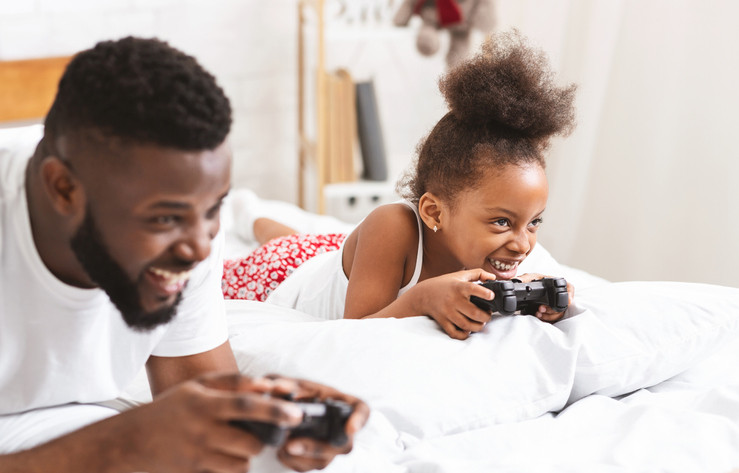

There’s no way around it, we are living in a digital world. No matter where you are or what you do, technology is everywhere. And while this access to technology is beneficial in many ways, it often leaves parents wondering how screen time affects their child. Is allowing my child to play video games bad parenting? Do my kids need their own phones? How do I enforce boundaries with technology? So many questions come to mind when thinking about parenting and technology.
Because your child will inevitably be required to use technology in their daily lives, whether it be for education, work, or entertainment purposes, you want to set them up for success. This means balancing teaching digital literacy with non-screen activities. In today’s blog I will walk you through what researchers are saying as well as how to implement their advice.
Before reading about limitations and regulations of technology, please keep in mind that these are the five most common types of screen time for children:

The five types of screen time mentioned above can be used for two different purposes: education and entertainment. The problem parents often encounter when setting screen time limits, is that they do not take into consideration that one hour of educational screen time is not the same as one hour of entertainment screen time.
Technology for entertainment is what many parents think of when thinking about screen time. Things like watching TV and scrolling through social media are passive forms of entertainment, and the form of entertainment child development researchers are most concerned about. Oftentimes, entertainment technology is passive entertainment, meaning there is no give-and-take. A person can mindlessly watch TV or play certain video games without truly having to consider what is taking place in front of them. And recent research shows that children watch an average of 2-4 hours of television per day. This focus on passive entertainment has led to less goal-oriented play and lower scores on language proficiency tests.
The National Center for Health Research found that children playing in a room with a TV on in the background play less intensely and creatively than those in a room without a TV. Additionally, parents in the same room were less attentive to their children and gave less encouragement.
Scary? Yes. But keep in mind there is still technology for education. So what does that look like?
Educational technology is more interactive. When children use technology for education they have to think critically about what is taking place on screen and interact with it in a goal-oriented manner. For example, when a child plays Math Monster on www.loonylearn.com, they have to not only answer the math question correctly, but also analyze the best route for the monster to take to get to the answer. They have to strategize, and receive corrective feedback on their actions. This type of technology uses different parts of the brain than passive entertainment technology.
What’s more, educational screen time trains children how to use technology--something they need to learn. If your child doesn’t understand how to navigate a web page or create a PowerPoint, they will not be prepared for the future. This is why educational technology is necessary to incorporate into a child’s daily life and something to consider when developing screen time limitations.
Over the past 15 years access to technology has become more widespread. During this time researchers have been frantically trying to put together studies to discover what the effects of this digital explosion will be. However, the focus of much of this research has been on the negative aspects of technology, and little has been done to uncover its benefits. Additionally, because this is a relatively new field, there is still much research that needs to be done. As such, many of the recommendations these organizations have published have changed over the years as more data is compiled.
Many researchers, including organizations like the National Center for Health Research, the World Health Organization, and the American Academy of Pediatrics provide recommendations for screen time limitations. While these recommendations may change, here is what these organizations are currently saying about screen time for children:

So how do you, as a parent, take this knowledge and apply it to your children? The first thing to do is to develop a plan.
Here are some things to consider when writing your technology plan:
If the thought of developing your own technology plan is overwhelming, here is a template you can use.
After you have created your plan, sit down with your children and explain to them the plan and why these guidelines are important. If you explain your reasoning to your children, they are more likely to respect the limitations.
Once you have done this, hang the rules somewhere so the kids can see it, and begin establishing these rules as norms. Sit down with your child and ask them if they want to spend some of their educational technology time with you. Teach them how to navigate the websites, and tell them that if they have any questions or concerns about technology they can come to you. Having an open line of communication and trust will make sticking to the plan much easier.
I hope this helped you understand the current technology recommendations and how to establish technology guidelines with your child. If you have any other topics you would like me to cover, or have questions about today’s blog, email info@loonylearn.com.